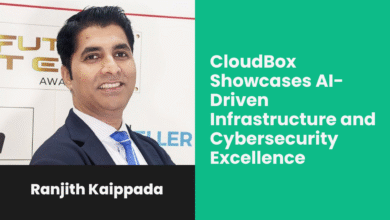Lenovo Calls for AI-Driven Cyber Resilience to Secure Smart Devices and Critical Infrastructure

As cybercriminals weaponize artificial intelligence to launch adaptive attacks, Lenovo’s CTO for Infrastructure Group, META, Ashley Woodbridge, warns that basic protections are no longer enough. He outlines how AI-powered cybersecurity, multi-layered defenses, and collaboration between manufacturers, service providers, and regulators are key to safeguarding smart devices and national infrastructure across the Middle East.
Why are most smart home devices still vulnerable despite basic security measures?
At Lenovo, we recognize that while basic security measures such as encryption, password protection, and firewalls are important, they alone are not enough to fully secure smart home devices. The reality is that many vulnerabilities exist beneath the surface layer of protection, at the firmware, protocol, or implementation level.
There are several reasons for this:
- Firmware Complexity: Vulnerabilities in firmware or device drivers can bypass traditional protections and are often harder to patch.
- Implementation Gaps: Even when global security standards are used, mistakes or outdated libraries can leave openings.
- Update Challenges: Smart home devices frequently remain in homes for years, and not all consumers update them promptly – creating extended exposure to risks.
- Default Configurations: Weak or default credentials, as well as insecure default settings, can make devices easier targets.
We work proactively to address these challenges through transparent product security advisories, ongoing collaboration with security researchers, and the rapid release of patches when issues are identified. Ultimately, the vulnerability of many smart home devices underscores the need for multi-layered, continuous security – not just basic measures, but robust firmware integrity checks, secure update processes, and responsible vendor support.
How are cybercriminals using AI to launch advanced attacks — and how can AI fight back?
Cybercriminals are increasingly turning to AI to scale phishing, automate reconnaissance, and create malware that adapts in real time – raising the stakes for organizations across the Middle East, where digital transformation is accelerating under Saudi Vision 2030 and the UAE’s National AI Strategy 2031.
At Lenovo, we are embedding AI into our security portfolio – from Cyber Resiliency as a Service, which uses AI-driven detection to cut response times from hours to minutes, to ThinkShield with embedded AI endpoint security. Our focus is on building cyber resilience that keeps pace with national ambitions in the region, ensuring enterprises and governments can innovate with confidence while staying protected against AI-powered threats.
What advanced steps can households and businesses take beyond passwords and updates?
Earlier this year, The UAE Cyber Security Council revealed that cyberattacks targeting strategic sectors in the country have reached more than 200,000 daily. Passwords and updates are only the first line of defense. At Lenovo, we recommend households and businesses adopt multi-layered security practices — starting with multi-factor authentication, secure Wi-Fi networks, and separating IoT devices onto distinct networks to limit exposure. For businesses, AI-powered endpoint protection, like Lenovo ThinkShield with embedded SentinelOne AI security, provides continuous monitoring and automated threat response.
What cybersecurity strategy needs to be adopted to counter AI-driven threats?
Countering AI-driven threats requires moving from a defensive posture to one of cyber resiliency. At Lenovo, we emphasize that organizations should not only focus on preventing breaches, but also on anticipating, withstanding, and rapidly recovering from them. This means adopting a zero-trust framework that continuously verifies users and devices, embedding AI-driven monitoring that can spot subtle anomalies at scale, and ensuring that incident response is automated and measured in minutes, not hours.
Equally important is building security into the entire technology lifecycle – from secure-by-design devices and firmware protection, to managed services like Lenovo’s Cyber Resiliency as a Service, which provides 24/7 AI-powered threat hunting and response. Against adaptive, AI-enabled adversaries, resilience, speed, and layered defenses are the strategy that keeps businesses one step ahead.
How can manufacturers, providers, and regulators work together to secure smart devices?
Collaboration is essential. Manufacturers must design products with security-by-design principles, including strong default configurations, secure firmware, and rapid patch processes. Service providers can add a layer of protection by enforcing network-level safeguards and monitoring, while regulators play a critical role in setting clear, enforceable security baselines across the market. When these three groups work in tandem, it ensures consistency, accountability, and ultimately safer smart devices for consumers and enterprises alike.
What risks do insecure smart devices pose to critical infrastructure and public safety?
Insecure devices don’t just put personal data at risk, they can become gateways into critical infrastructure networks if compromised. A poorly secured IoT camera or sensor, for example, can be hijacked to launch large-scale denial-of-service attacks or provide entry points into more sensitive systems. For governments and enterprises in energy, transport, and healthcare, this creates risks not only to operations and continuity, but also to public safety if essential services are disrupted. Lenovo emphasizes building resilience at both the device and infrastructure level to mitigate these cascading risks.
How can consumer awareness be improved to reduce smart device vulnerabilities?
Technology alone isn’t enough. Consumers must also be empowered. Lenovo sees education and awareness as critical: campaigns that highlight the importance of changing default passwords, enabling automatic updates, and isolating smart devices on home networks can make a real difference. Clear labeling standards, backed by regulators and manufacturers, can also help buyers quickly understand the security posture of a device before purchase. Ultimately, when consumers know what to do and why it matters, they become an active part of the defense ecosystem.





